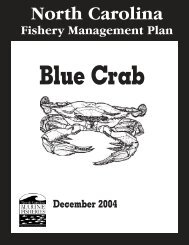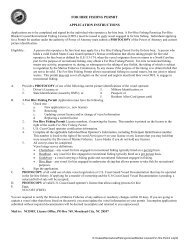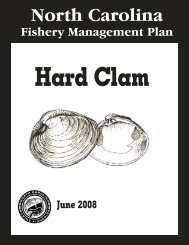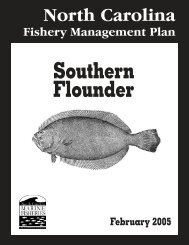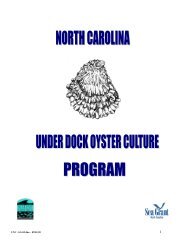Striped Mullet FMP - NC Dept. of Environment and Natural Resources
Striped Mullet FMP - NC Dept. of Environment and Natural Resources
Striped Mullet FMP - NC Dept. of Environment and Natural Resources
You also want an ePaper? Increase the reach of your titles
YUMPU automatically turns print PDFs into web optimized ePapers that Google loves.
5. STATUS OF STOCK5.1 GENERAL LIFE HISTORYGlossary <strong>of</strong> Biological TermsBackgroundA glossary <strong>of</strong> biological terms can be found in the Appendix 1.<strong>Striped</strong> mullet (Mugil cephalus) occur worldwide, predominantly in sub-tropical to tropicallatitudes (Collins 1985a). Along the western Atlantic, striped mullet have been documentedfrom Nova Scotia to Brazil, although stages older than young-<strong>of</strong>-the-year (YOY) are notcommonly reported into the Middle Atlantic Bight (Able <strong>and</strong> Fahay 1998). The striped mullet isalso known as the jumping mullet, black mullet, grey mullet, popeye mullet, whirligig mullet,common mullet, molly, callifavor, menille, liza, <strong>and</strong> lisa (Ibanez-Aguirre et al. 1995; Leard et al.1995).The striped mullet, white mullet (Mugil curema), <strong>and</strong> mountain mullet (Agonostomusmonitcola) are the three Mugilid species found in North Carolina. <strong>Striped</strong> mullet <strong>and</strong> whitemullet are similar in appearance, but can be taxonomically distinguished by anal fin ray countsor pectoral fin measurements (Collins 1985a; Collins 1985b). <strong>Striped</strong> mullet possess 11 anal finelements: 3 anal spines <strong>and</strong> 8 anal fin rays, <strong>and</strong> the pectoral fins are 66 to 74% <strong>of</strong> the headlength; white mullet possess 12 anal fin elements: 3 anal spines <strong>and</strong> 9 anal fin rays, <strong>and</strong> thepectoral fin lengths are 77 to 84% <strong>of</strong> the head length (Collins 1985a; Collins 1985b). <strong>Striped</strong>mullet also develop longitudinal stripes along the body by its juvenile stage. White mullet lackstripes <strong>and</strong> possess a distinct gold spot on the opercle (gill cover). Juvenile white mullet arecommonly found during summer months in estuarine habitats shared by striped mullet (Martin<strong>and</strong> Drewry 1978; DMF unpublished data). In North Carolina, white mullet demonstrate aseaward emigration during the fall months, presumably migrating to Florida or southwards(Collins 1985b). Reproductive activity <strong>of</strong> white mullet in North Carolina waters is notdocumented. White mullet older than age 1+ are rarely collected north <strong>of</strong> Florida (Anderson1958). One specimen <strong>of</strong> mountain mullet was noted in Brunswick County, North Carolina(Rohde 1976).All body lengths (st<strong>and</strong>ard length (SL), fork length (FL), or total length (TL)) cited fromscientific literature are reported as TL in this section (Figure 5.1).14




